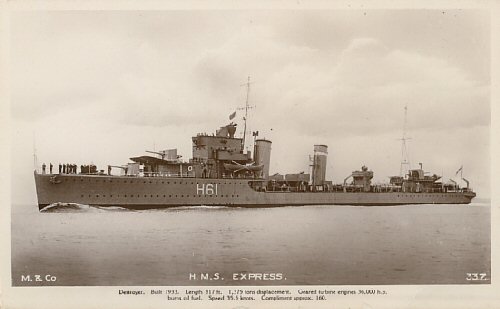
Broken up. 1955
HMS Express (H61) was an E class destroyer of the Royal Navy. She was one of 16 'E' and 'F' class destoyers to be built.
She was launched on May 29 1934. She had an overall length of 100 m, displacement of 1,375 tons, and a maximum speed of 35.5 knots (66 km/h). Her design was similar to the 'C' and 'D' classes of 1931, but with an improved hull form, modified bridge, 3 boiler rooms instead of 2, and 4.7 inch guns that could elevate to 40 degrees (vs. 30 degrees on earlier classes). She cost approximately 300,000 British Pounds to build.
She and her sister Esk were fitted as minelayers. Unlike the others of the class, Esk and Express had tripod mainmasts and carried their ship's boats on the foredeck.
Minelaying with the 20th Destroyer Flotilla:
On the outbreak of war in September 1939, Express was assigned to the 20th (Minelaying) Destroyer Flotilla, initally based at Portsmouth before moving to Immingham on the North Sea. Express spent the first year of the war laying defensive minefields in British waters and offensive minefields off enemy coasts with the 20th Flotilla.
In September 1939 she took the Duke and Duchess of Windsor from Portsmouth to Cherbourg.
In late May 1940, Express was one of several dozen destroyers ordered to help evacuate the British Expeditionary Force from Dunkirk, and was one of the first to arrive and begin taking troops off the beaches. Later troops were taken off from Dunkirk harbour. The Express and the destroyer Shikari were the last ships to leave Dunkirk with troops before the evacuation ended on June 4th. She brought out 2,795 troops over the course of the evacuation. She was damaged by bombing, but was repaired in time to continue taking part in the evacuation.
31 August 1940: Left Immingham to lay an offensive mine field off the coast of the Netherlands. During the night, Express struck a mine, losing her entire bow up to the bridge. Esk and Ivanhoe then struck mines while trying to go to her assistance. Express was towed back to Britain, having lost 4 officers and 55 ratings. Esk and Ivanhoe were lost.
To the Far East:
She returned to service in September 1941 as a fleet destroyer.
In October, she was ordered to escort the battleship HMS Prince of Wales to the Far East with her sister HMS Electra where the ships would form the nucleus of a new Eastern Fleet intended to deter Japanese aggression.
On 2 November, the three ships put into Freetown. They arrived at Cape Town on 16 November, with the destroyers putting into Simonstown Naval Base. They left Cape Town on 18 November and arrived at Colombo, Ceylon, on 28 November, stopping at Mauritius and Addu Atoll to refuel on the way.
On 29 November, the destroyers HMS Encounter and HMS Jupiter joined at Colombo from the Mediterranean Fleet and the five ships sailed later that day. The ships were joined at sea by the battlecruiser HMS Repulse which had sailed from Trincomalee. The force then set course for Singapore, where they arrived on 2 December.
Force Z at Singapore:
Early in the morning of 8 December (Singapore time), Singapore came under attack by Japanese aircraft. Prince of Wales and Repulse shot back with anti-aircraft fire; no planes were shot down, and the ships sustained no damage. After receiving the reports of the attack on Pearl Harbor and invasions of Siam by the Japanese, Force Z put to sea at 1730 hrs. on 8 December. Force Z at this time consisted of the Prince of Wales and Repulse, escorted by the destroyers Electra, Express, Vampire, and Tenedos. At about 1830 on 9 December, the Tenedos was detached to return to Singapore, because of her limited fuel capacity. That night, Electra sighted and reported a flare to the north. This caused the British force to turn away to the southeast. The flare was dropped by a Japanese aircraft over their own ships by mistake, and caused the Japanese force to turn away to the northeast. At this point, the two forces were only about five miles apart.
At 2055, Admiral Philips cancelled the operation, and ordered the force to return to Singapore. On the way back, they were spotted and reported by the Japanese submarine I-58. The next morning, 10 December, they received a report of Japanese landings at Kuantan, and Express was sent to investigate the area, finding nothing. That afternoon, Prince of Wales and Repulse were attacked and sunk by 85 Japanese aircraft off Kuantan. Repulse was sunk by five torpedoes in 20 minutes, and Electra and Vampire moved in to rescue survivors of Repulse, while Express rescued survivors of the Prince of Wales. The three destroyers rescued over 1,000 survivors from the Prince of Wales and Repulse.
She spent 1942 in the Indian Ocean as part of the British Eastern Fleet before returning home to refit.
HMCS Gatineau:
In June 1943, she was transferred to the Canadian Navy as HMCS Gatineau and served with distinction in the Atlantic.
1955: Broken up.